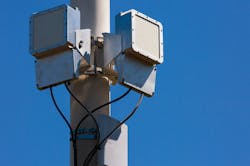New Software Targets Phased Array Antennas with Beamforming
Armed with new software from Keysight Technologies, engineers will have the ability to test antenna arrays that employ algorithms to shoot wireless signals in specific directions. Keysight will include the new tool in the latest version of its popular SystemVue design software for wireless components, which is scheduled for release later this year.
The software is designed for phased array antennas, in which the phase of the antenna can be calibrated to send signals in one direction and suppress signals in other directions. Though these antenna arrays can be pointed in one direction permanently, other kinds of phased array antennas can steer narrow beams of radiation using specialized algorithms. This approach is known as beamforming.
In response to sharp increases in the amount of cellular data that the average person consumes, wireless carriers are turning to phased array antennas with beamforming to make their wireless equipment more efficient. Pointing signals directly at mobile phones and other handheld devices, wireless carriers have been able to increase the overall capacity of their networks.
Several internet companies trying to muscle into wireless service have started using phased array antennas. Facebook, which has plans to expand wireless access in cities and the developing world, built its millimeter-wave Terragraph system around phased array antenna. The company’s engineers have said that beamforming helps to steer the millimeter wave around walls and buildings and protect signals from being absorbed into the atmosphere.
Keysight’s Phased Array Beamforming Kit helps engineers working on these systems to model interference and power consumption. Using the software, engineers can model parallel wireless architectures, testing single beams or tracking individual signals passing through phased arrays. It can also be used to validate 3D conformal arrays using active signaling between multiple transmitters and receivers.
The ability to model antenna behavior on the system level can be helpful for engineers dealing with the huge amount of antenna elements in phased arrays. One type of phased array antenna known as active electronically-scanned arrays can contain from 16 to 256 elements in experimental 5G systems. That number grows to hundreds of elements in satellite systems, and thousands of individual baseband and RF signal paths in military systems.
“Organizations delivering products with phased-array subsystems typically use 5 to 10 different, unconnected design tools, not counting spreadsheets,” said Daren McClearnon, system-level marketing manager with Keysight’s Electronic Design Automation division.
The toolkit combines algorithmic research and application references for communications and radar, allowing users to “cross-validate both the RF and baseband from proposal to test, using a common framework,” McClearnon said. The simulation software that will support the phased array toolkit, SystemVue 2016.08, is expected to be released later this year.
Keysight is also building new software tools for technologies related to beamforming, such as multiple-input, multiple-output (MIMO), which segments the signal beam into multiple strands. Using this approach, operators can choose to send data into multiple devices simultaneously or fill one device with multiple beams to improve download speed.
Not long before it revealed the new phased array software, Keysight said that it would partner with the China Mobile Research Institute on testing Massive MIMO systems. The work will focus on developing channel measurement and modeling tools. To that end, the companies will test CMRI’s Massive MIMO antenna array to generate channel models.
About the Author

James Morra
Senior Editor
James Morra is the senior editor for Electronic Design, covering the semiconductor industry and new technology trends, with a focus on power electronics and power management. He also reports on the business behind electrical engineering, including the electronics supply chain. He joined Electronic Design in 2015 and is based in Chicago, Illinois.
